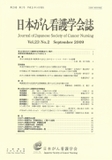Japanese
English
- 販売していません
- Abstract 文献概要
- 参考文献 Reference
- サイト内被引用 Cited by
要旨
本研究は,乳がん体験者の術後上肢機能障害に対する主観的認知と客観的評価の関連を明らかにし,障害の予防改善に向けた介入の有効性を検証する測定方法の検討を目的とした.術後1年以内で外来通院中の乳がん体験者62名(平均年齢55.9±11.9歳)に,乳がん体験者の術後上肢機能障害に対する主観的認知尺度の6項目を用いた質問紙調査と上肢機能(前腕上腕周径・肩関節可動域・握力)の測定を行った.その結果,腫脹と筋力低下の発症率は主観的認知が,肩関節可動域の縮少は客観的評価が高かった.腫脹,肩関節可動域の縮少,握力低下に対する主観的認知と客観的評価の間には「手術した側の腕を肘を曲げずに横に広げて耳の高さまであがらない」と外転差(rs=.25;p<.05),「手術した側の腕を肘を曲げずに横に広げて後ろにそらせない」と水平伸展差(rs=.28;p<.05)に有意な正の相関がみられた.しかし,腕周径,肩関節屈曲,握力に関しては測定方法間に相関がみられなかった.また,客観的評価で症状ありに対して主観的認知なしの割合は50〜78.1%,客観的評価で症状なしに対して主観的認知ありの割合は11.4〜34.7%であった.このことは,乳がん術後上肢機能障害のアセスメントには,主観的認知と客観的評価の併用が有用であることを示唆している.
Abstract
The present study aimed to clarify the relation between subjective perception and objective assessment of postoperative functional impairment of the arms in breast cancer survivors, and to thereby identify suitable measurement methods for preventing and improving such impairment. Subjects were 62 breast cancer survivors who had undergone surgery within the past year and were receiving treatment on an outpatient basis(mean age 55.9±11.9 years). Each completed a six-item questionnaire survey on the subjective perception of postoperative functional impairment of the arms. Objective measurements related to arm function(forearm and upper arm girth, shoulder range of motion, and grip strength)were also conducted.
Results showed that swelling and reduced muscle strength were more common on subjective assessment, and that limited mobility or frozen shoulder was more common on objective assessment. Regarding the subjective perception and objective assessment of swelling, limited mobility or frozen shoulder, and reduced grip strength, significant positive correlations were observed between "cannot raise the arm on the operated side sideways up to the level of the ear without bending the elbow" and limitation of abduction(rs=.25 ; p<.05), and between "cannot raise the arm on the operated side sideways and move it backwards without bending the elbow" and limitation of horizontal extension(rs=.28 ; p<.05). However, there was no correlation between the measurement methods for arm girth, shoulder joint movement, and grip strength. Moreover, among patients who had objective findings, 50% to 78.1% did not have subjectively perceived symptoms, and among those who did not have objective findings, 11.4% to 34.7% had subjectively perceived symptoms. This indicates that it is necessary to use both subjective perception and objective assessment when assessing functional impairment of the arm following breast cancer surgery.
Copyright © 2009, Japanese Society of Cancer Nursing All rights reserved.


